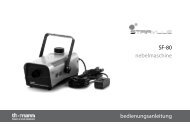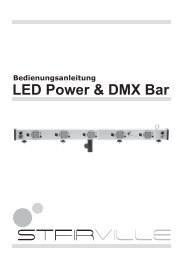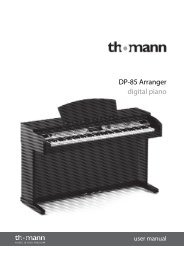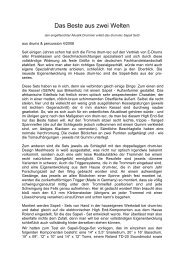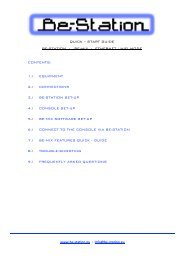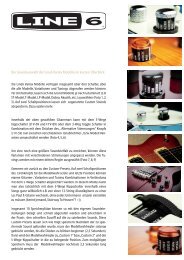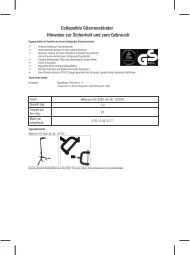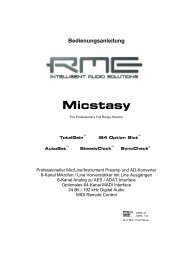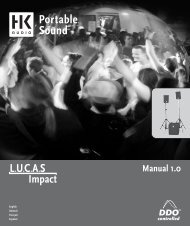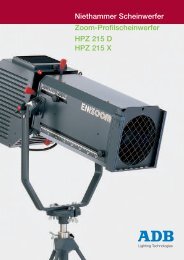You also want an ePaper? Increase the reach of your titles
YUMPU automatically turns print PDFs into web optimized ePapers that Google loves.
Noise Gate<br />
A noise gate is a type of dynamics processor that mutes or attenuates the input signal until<br />
its amplitude exceeds an adjustable threshold level, at which time the gate ‘opens’ to allow<br />
audio through at its actual level.<br />
They are often used during drum mixing in order to isolate drums within signals containing<br />
bleed or spill from other drums. Another common use is to reduce the decay of toms and<br />
kicks. Noise gates are often referred to simply as ‘gates’.<br />
While BFD2 contains bleed in the kick and snare channels, it can easily be turned off<br />
rather than having to use gates to minimize bleed. Likewise, the decay of kit-pieces can be<br />
adjusted using the damping controls in the kit-piece inspector. However, using gates can be<br />
good for creative effects, or simply for recreating the types of techniques used in real drum<br />
mixing sessions.<br />
BFD2’s Noise gate has a sidechain function, allowing you to create triggered pulsing effects very easily. For example, route any<br />
channel such as a hihat or a user sample direct channel to the master channel’s sidechain input and insert a noise gate in one of<br />
the master channel’s effect slots. Enable the sidechain button for the gate and adjust the threshold until the sidechain input triggers<br />
the audio on the channel.<br />
When setting very fast attack and release times, it is common to hear ‘clicks’ in the audio, especially with sounds predominantly<br />
comprised of low frequencies such as kicks and toms – this is totally normal and you simply need to increase these times slightly<br />
to eradicate the problem.<br />
Attack<br />
This controls the speed at which the gate opens once the threshold has been exceeded by the input signal’s amplitude.<br />
Hold<br />
This parameter controls the amount of time the gate remains open after the input signal has dropped below the threshold level.<br />
Release<br />
This controls the speed at which the gate closes at the end of the hold time.<br />
Threshold<br />
This control allows you to set the level at which the gate starts to open. When the input signal amplitude exceeds the level specified<br />
by the Threshold control, the gate starts to open to allow audio through.<br />
SC<br />
Like the compressors, the NoiseGate features a sidechain function. By enabling the SC (Sidechain) button, the gate reacts to the<br />
channel’s sidechain input rather than the main input, while still applying the gating process to the main input. This allows you to<br />
control the gating of the main input signal with another signal entirely.<br />
LP Freq & HP Freq<br />
These controls allow you to filter the input signal used to trigger the gate, while leaving the actual processed signal unfiltered. This<br />
allows you to isolate certain frequencies in the input to improve the gating response – for example, excessive low frequencies in<br />
the input can make the gate react more than required.<br />
It is important to remember that these filters affect only the key signal used to trigger the gate, whether it is the main input or the<br />
sidechain input. They are not applied to the processed signal.<br />
Key Listen<br />
Enabling the Listen button lets you hear the key input being used to trigger the NoiseGate’s amplitude detection circuit instead of<br />
the processed input signal. The key signal can be either the main input or the sidechain input.<br />
It is very useful when using the LP and HP filters and/or the sidechain input.<br />
Hysteresis<br />
Noise gates have a tendency to open and close very quickly when the input signal’s amplitude remains close to the threshold<br />
level for longer periods, something that can result in ‘gate chatter’.<br />
Increasing the Hysteresis control smooths out the gate response to reduce this problem, although the gate becomes less sensitive<br />
to small changes around the threshold level.<br />
Mix<br />
With the Mix control at 100%, the BFD2 NoiseGate mutes the signal completely when closed. If you want to let the signal through<br />
at a low level, decrease the Mix control to allow more of the dry signal through.<br />
1 1



